Analyzing Consumer Behavior
VerifiedAdded on 2023/06/11
|9
|2527
|157
AI Summary
This essay analyzes consumer behavior using personality and demographic theories. It also suggests marketing strategies using classical, operant, and cognitive learning theories.
Contribute Materials
Your contribution can guide someone’s learning journey. Share your
documents today.
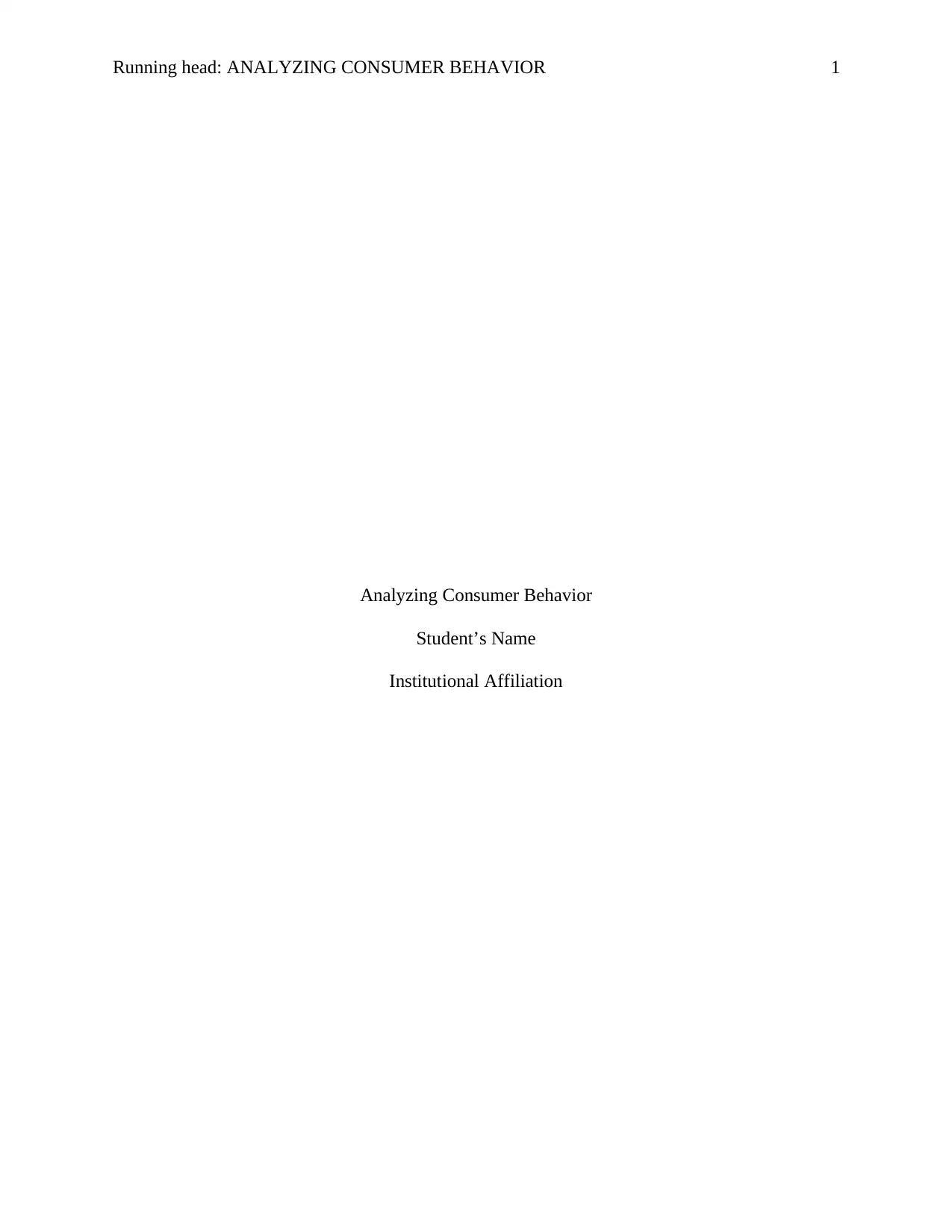
Running head: ANALYZING CONSUMER BEHAVIOR 1
Analyzing Consumer Behavior
Student’s Name
Institutional Affiliation
Analyzing Consumer Behavior
Student’s Name
Institutional Affiliation
Secure Best Marks with AI Grader
Need help grading? Try our AI Grader for instant feedback on your assignments.
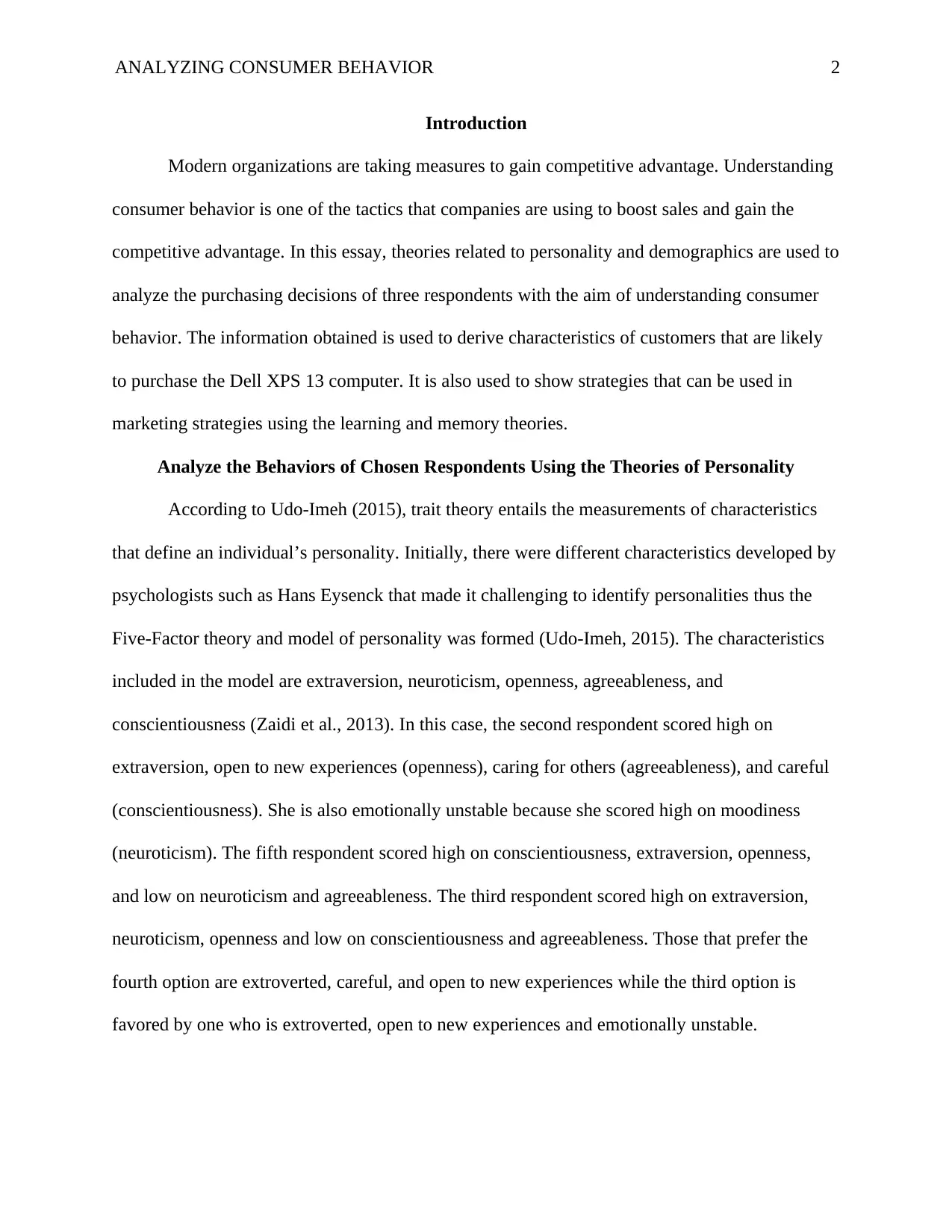
ANALYZING CONSUMER BEHAVIOR 2
Introduction
Modern organizations are taking measures to gain competitive advantage. Understanding
consumer behavior is one of the tactics that companies are using to boost sales and gain the
competitive advantage. In this essay, theories related to personality and demographics are used to
analyze the purchasing decisions of three respondents with the aim of understanding consumer
behavior. The information obtained is used to derive characteristics of customers that are likely
to purchase the Dell XPS 13 computer. It is also used to show strategies that can be used in
marketing strategies using the learning and memory theories.
Analyze the Behaviors of Chosen Respondents Using the Theories of Personality
According to Udo-Imeh (2015), trait theory entails the measurements of characteristics
that define an individual’s personality. Initially, there were different characteristics developed by
psychologists such as Hans Eysenck that made it challenging to identify personalities thus the
Five-Factor theory and model of personality was formed (Udo-Imeh, 2015). The characteristics
included in the model are extraversion, neuroticism, openness, agreeableness, and
conscientiousness (Zaidi et al., 2013). In this case, the second respondent scored high on
extraversion, open to new experiences (openness), caring for others (agreeableness), and careful
(conscientiousness). She is also emotionally unstable because she scored high on moodiness
(neuroticism). The fifth respondent scored high on conscientiousness, extraversion, openness,
and low on neuroticism and agreeableness. The third respondent scored high on extraversion,
neuroticism, openness and low on conscientiousness and agreeableness. Those that prefer the
fourth option are extroverted, careful, and open to new experiences while the third option is
favored by one who is extroverted, open to new experiences and emotionally unstable.
Introduction
Modern organizations are taking measures to gain competitive advantage. Understanding
consumer behavior is one of the tactics that companies are using to boost sales and gain the
competitive advantage. In this essay, theories related to personality and demographics are used to
analyze the purchasing decisions of three respondents with the aim of understanding consumer
behavior. The information obtained is used to derive characteristics of customers that are likely
to purchase the Dell XPS 13 computer. It is also used to show strategies that can be used in
marketing strategies using the learning and memory theories.
Analyze the Behaviors of Chosen Respondents Using the Theories of Personality
According to Udo-Imeh (2015), trait theory entails the measurements of characteristics
that define an individual’s personality. Initially, there were different characteristics developed by
psychologists such as Hans Eysenck that made it challenging to identify personalities thus the
Five-Factor theory and model of personality was formed (Udo-Imeh, 2015). The characteristics
included in the model are extraversion, neuroticism, openness, agreeableness, and
conscientiousness (Zaidi et al., 2013). In this case, the second respondent scored high on
extraversion, open to new experiences (openness), caring for others (agreeableness), and careful
(conscientiousness). She is also emotionally unstable because she scored high on moodiness
(neuroticism). The fifth respondent scored high on conscientiousness, extraversion, openness,
and low on neuroticism and agreeableness. The third respondent scored high on extraversion,
neuroticism, openness and low on conscientiousness and agreeableness. Those that prefer the
fourth option are extroverted, careful, and open to new experiences while the third option is
favored by one who is extroverted, open to new experiences and emotionally unstable.
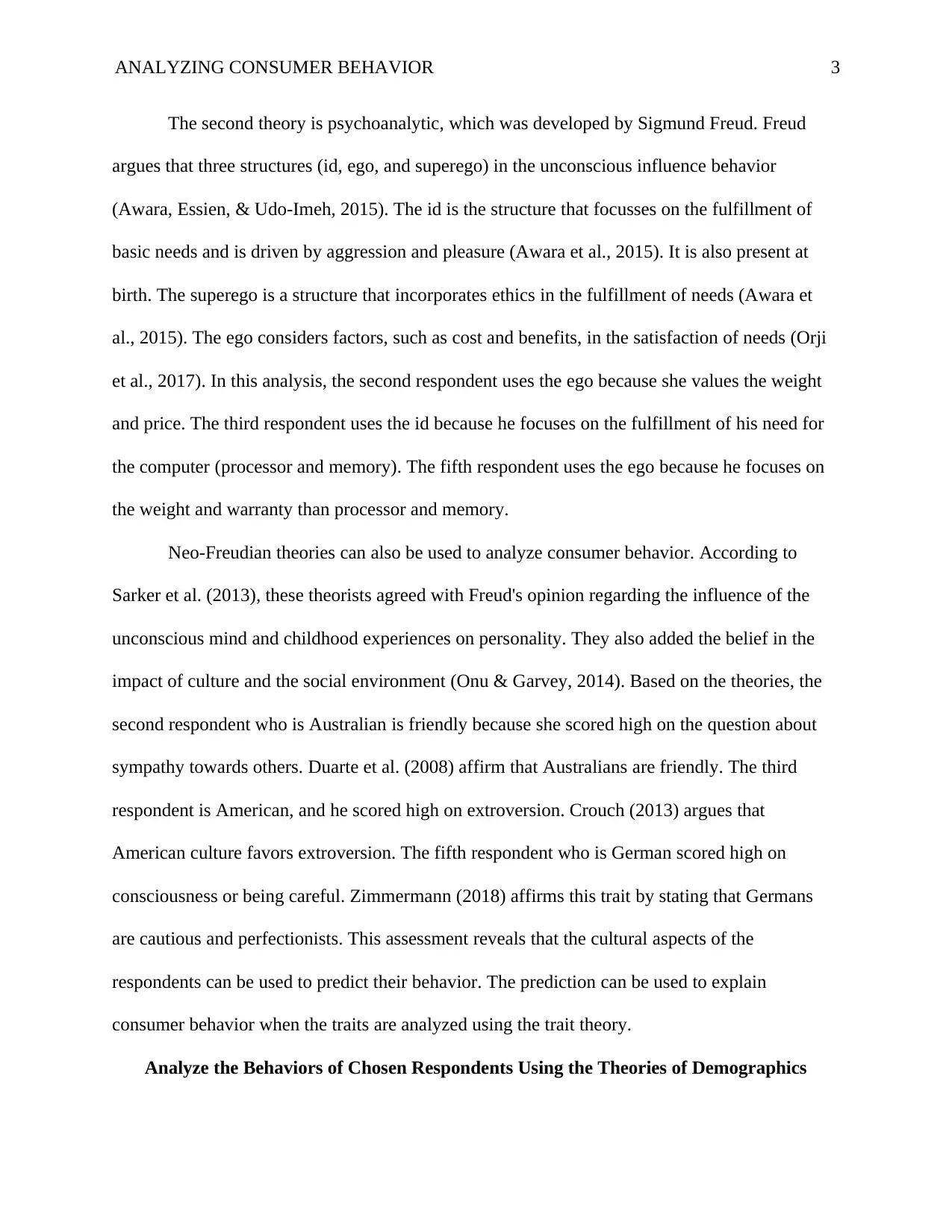
ANALYZING CONSUMER BEHAVIOR 3
The second theory is psychoanalytic, which was developed by Sigmund Freud. Freud
argues that three structures (id, ego, and superego) in the unconscious influence behavior
(Awara, Essien, & Udo-Imeh, 2015). The id is the structure that focusses on the fulfillment of
basic needs and is driven by aggression and pleasure (Awara et al., 2015). It is also present at
birth. The superego is a structure that incorporates ethics in the fulfillment of needs (Awara et
al., 2015). The ego considers factors, such as cost and benefits, in the satisfaction of needs (Orji
et al., 2017). In this analysis, the second respondent uses the ego because she values the weight
and price. The third respondent uses the id because he focuses on the fulfillment of his need for
the computer (processor and memory). The fifth respondent uses the ego because he focuses on
the weight and warranty than processor and memory.
Neo-Freudian theories can also be used to analyze consumer behavior. According to
Sarker et al. (2013), these theorists agreed with Freud's opinion regarding the influence of the
unconscious mind and childhood experiences on personality. They also added the belief in the
impact of culture and the social environment (Onu & Garvey, 2014). Based on the theories, the
second respondent who is Australian is friendly because she scored high on the question about
sympathy towards others. Duarte et al. (2008) affirm that Australians are friendly. The third
respondent is American, and he scored high on extroversion. Crouch (2013) argues that
American culture favors extroversion. The fifth respondent who is German scored high on
consciousness or being careful. Zimmermann (2018) affirms this trait by stating that Germans
are cautious and perfectionists. This assessment reveals that the cultural aspects of the
respondents can be used to predict their behavior. The prediction can be used to explain
consumer behavior when the traits are analyzed using the trait theory.
Analyze the Behaviors of Chosen Respondents Using the Theories of Demographics
The second theory is psychoanalytic, which was developed by Sigmund Freud. Freud
argues that three structures (id, ego, and superego) in the unconscious influence behavior
(Awara, Essien, & Udo-Imeh, 2015). The id is the structure that focusses on the fulfillment of
basic needs and is driven by aggression and pleasure (Awara et al., 2015). It is also present at
birth. The superego is a structure that incorporates ethics in the fulfillment of needs (Awara et
al., 2015). The ego considers factors, such as cost and benefits, in the satisfaction of needs (Orji
et al., 2017). In this analysis, the second respondent uses the ego because she values the weight
and price. The third respondent uses the id because he focuses on the fulfillment of his need for
the computer (processor and memory). The fifth respondent uses the ego because he focuses on
the weight and warranty than processor and memory.
Neo-Freudian theories can also be used to analyze consumer behavior. According to
Sarker et al. (2013), these theorists agreed with Freud's opinion regarding the influence of the
unconscious mind and childhood experiences on personality. They also added the belief in the
impact of culture and the social environment (Onu & Garvey, 2014). Based on the theories, the
second respondent who is Australian is friendly because she scored high on the question about
sympathy towards others. Duarte et al. (2008) affirm that Australians are friendly. The third
respondent is American, and he scored high on extroversion. Crouch (2013) argues that
American culture favors extroversion. The fifth respondent who is German scored high on
consciousness or being careful. Zimmermann (2018) affirms this trait by stating that Germans
are cautious and perfectionists. This assessment reveals that the cultural aspects of the
respondents can be used to predict their behavior. The prediction can be used to explain
consumer behavior when the traits are analyzed using the trait theory.
Analyze the Behaviors of Chosen Respondents Using the Theories of Demographics
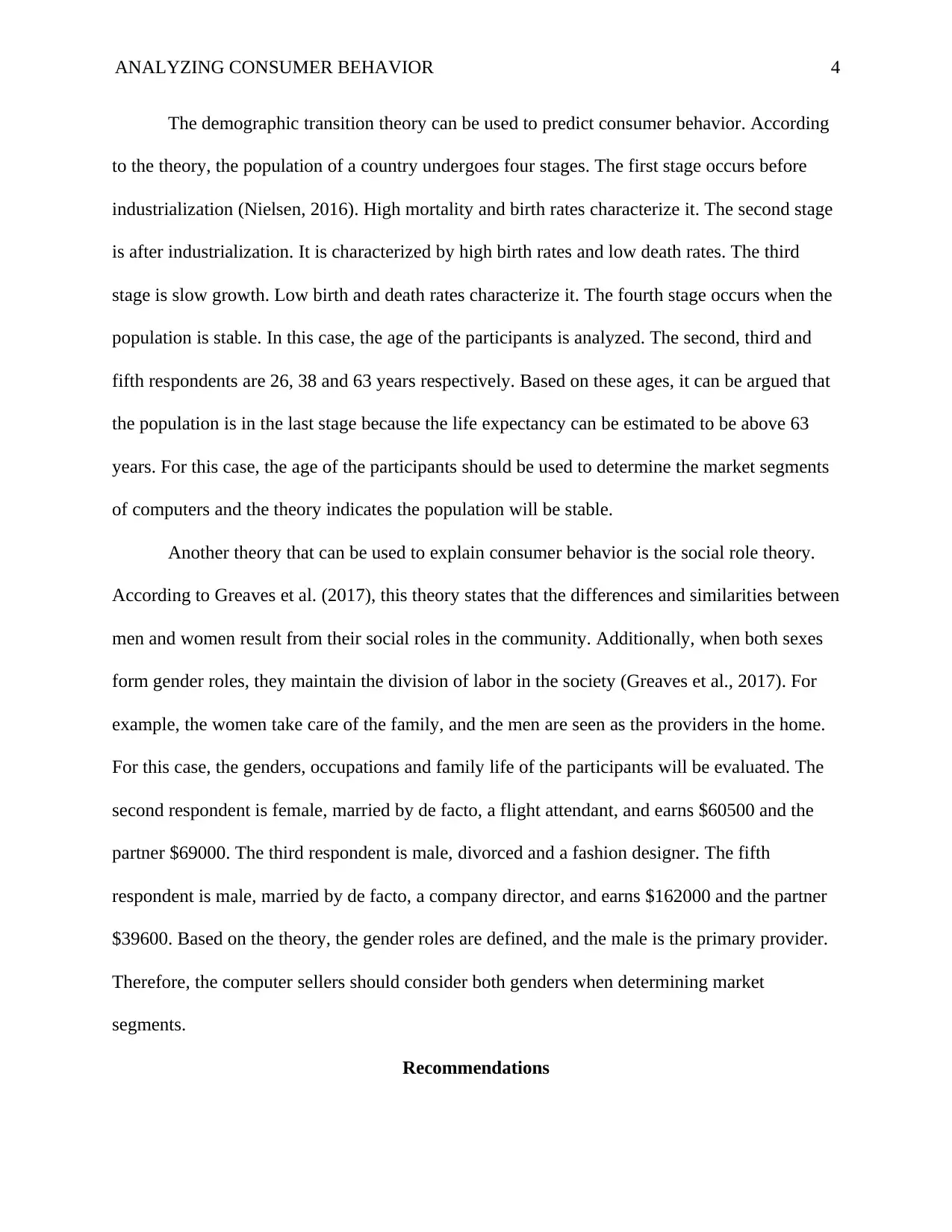
ANALYZING CONSUMER BEHAVIOR 4
The demographic transition theory can be used to predict consumer behavior. According
to the theory, the population of a country undergoes four stages. The first stage occurs before
industrialization (Nielsen, 2016). High mortality and birth rates characterize it. The second stage
is after industrialization. It is characterized by high birth rates and low death rates. The third
stage is slow growth. Low birth and death rates characterize it. The fourth stage occurs when the
population is stable. In this case, the age of the participants is analyzed. The second, third and
fifth respondents are 26, 38 and 63 years respectively. Based on these ages, it can be argued that
the population is in the last stage because the life expectancy can be estimated to be above 63
years. For this case, the age of the participants should be used to determine the market segments
of computers and the theory indicates the population will be stable.
Another theory that can be used to explain consumer behavior is the social role theory.
According to Greaves et al. (2017), this theory states that the differences and similarities between
men and women result from their social roles in the community. Additionally, when both sexes
form gender roles, they maintain the division of labor in the society (Greaves et al., 2017). For
example, the women take care of the family, and the men are seen as the providers in the home.
For this case, the genders, occupations and family life of the participants will be evaluated. The
second respondent is female, married by de facto, a flight attendant, and earns $60500 and the
partner $69000. The third respondent is male, divorced and a fashion designer. The fifth
respondent is male, married by de facto, a company director, and earns $162000 and the partner
$39600. Based on the theory, the gender roles are defined, and the male is the primary provider.
Therefore, the computer sellers should consider both genders when determining market
segments.
Recommendations
The demographic transition theory can be used to predict consumer behavior. According
to the theory, the population of a country undergoes four stages. The first stage occurs before
industrialization (Nielsen, 2016). High mortality and birth rates characterize it. The second stage
is after industrialization. It is characterized by high birth rates and low death rates. The third
stage is slow growth. Low birth and death rates characterize it. The fourth stage occurs when the
population is stable. In this case, the age of the participants is analyzed. The second, third and
fifth respondents are 26, 38 and 63 years respectively. Based on these ages, it can be argued that
the population is in the last stage because the life expectancy can be estimated to be above 63
years. For this case, the age of the participants should be used to determine the market segments
of computers and the theory indicates the population will be stable.
Another theory that can be used to explain consumer behavior is the social role theory.
According to Greaves et al. (2017), this theory states that the differences and similarities between
men and women result from their social roles in the community. Additionally, when both sexes
form gender roles, they maintain the division of labor in the society (Greaves et al., 2017). For
example, the women take care of the family, and the men are seen as the providers in the home.
For this case, the genders, occupations and family life of the participants will be evaluated. The
second respondent is female, married by de facto, a flight attendant, and earns $60500 and the
partner $69000. The third respondent is male, divorced and a fashion designer. The fifth
respondent is male, married by de facto, a company director, and earns $162000 and the partner
$39600. Based on the theory, the gender roles are defined, and the male is the primary provider.
Therefore, the computer sellers should consider both genders when determining market
segments.
Recommendations
Secure Best Marks with AI Grader
Need help grading? Try our AI Grader for instant feedback on your assignments.
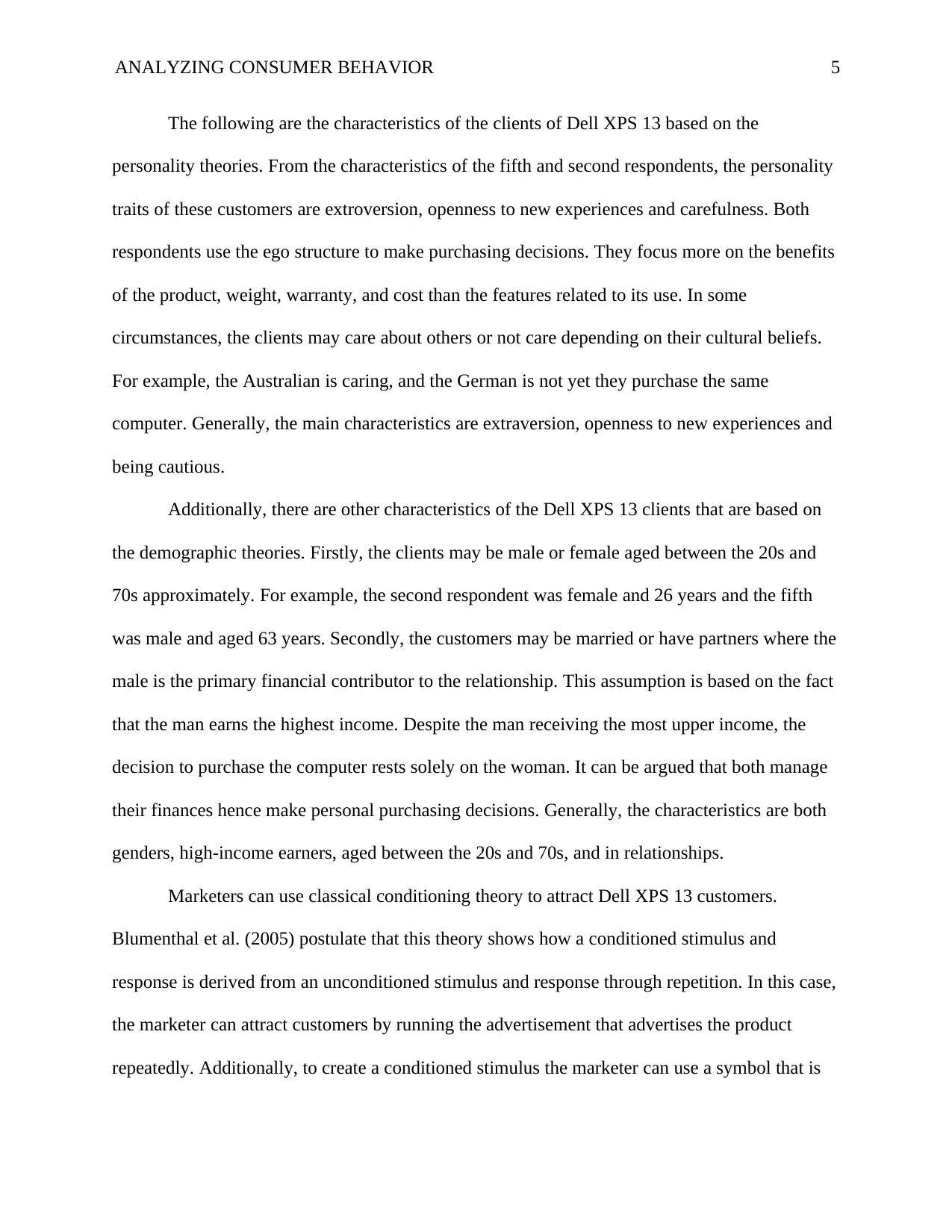
ANALYZING CONSUMER BEHAVIOR 5
The following are the characteristics of the clients of Dell XPS 13 based on the
personality theories. From the characteristics of the fifth and second respondents, the personality
traits of these customers are extroversion, openness to new experiences and carefulness. Both
respondents use the ego structure to make purchasing decisions. They focus more on the benefits
of the product, weight, warranty, and cost than the features related to its use. In some
circumstances, the clients may care about others or not care depending on their cultural beliefs.
For example, the Australian is caring, and the German is not yet they purchase the same
computer. Generally, the main characteristics are extraversion, openness to new experiences and
being cautious.
Additionally, there are other characteristics of the Dell XPS 13 clients that are based on
the demographic theories. Firstly, the clients may be male or female aged between the 20s and
70s approximately. For example, the second respondent was female and 26 years and the fifth
was male and aged 63 years. Secondly, the customers may be married or have partners where the
male is the primary financial contributor to the relationship. This assumption is based on the fact
that the man earns the highest income. Despite the man receiving the most upper income, the
decision to purchase the computer rests solely on the woman. It can be argued that both manage
their finances hence make personal purchasing decisions. Generally, the characteristics are both
genders, high-income earners, aged between the 20s and 70s, and in relationships.
Marketers can use classical conditioning theory to attract Dell XPS 13 customers.
Blumenthal et al. (2005) postulate that this theory shows how a conditioned stimulus and
response is derived from an unconditioned stimulus and response through repetition. In this case,
the marketer can attract customers by running the advertisement that advertises the product
repeatedly. Additionally, to create a conditioned stimulus the marketer can use a symbol that is
The following are the characteristics of the clients of Dell XPS 13 based on the
personality theories. From the characteristics of the fifth and second respondents, the personality
traits of these customers are extroversion, openness to new experiences and carefulness. Both
respondents use the ego structure to make purchasing decisions. They focus more on the benefits
of the product, weight, warranty, and cost than the features related to its use. In some
circumstances, the clients may care about others or not care depending on their cultural beliefs.
For example, the Australian is caring, and the German is not yet they purchase the same
computer. Generally, the main characteristics are extraversion, openness to new experiences and
being cautious.
Additionally, there are other characteristics of the Dell XPS 13 clients that are based on
the demographic theories. Firstly, the clients may be male or female aged between the 20s and
70s approximately. For example, the second respondent was female and 26 years and the fifth
was male and aged 63 years. Secondly, the customers may be married or have partners where the
male is the primary financial contributor to the relationship. This assumption is based on the fact
that the man earns the highest income. Despite the man receiving the most upper income, the
decision to purchase the computer rests solely on the woman. It can be argued that both manage
their finances hence make personal purchasing decisions. Generally, the characteristics are both
genders, high-income earners, aged between the 20s and 70s, and in relationships.
Marketers can use classical conditioning theory to attract Dell XPS 13 customers.
Blumenthal et al. (2005) postulate that this theory shows how a conditioned stimulus and
response is derived from an unconditioned stimulus and response through repetition. In this case,
the marketer can attract customers by running the advertisement that advertises the product
repeatedly. Additionally, to create a conditioned stimulus the marketer can use a symbol that is
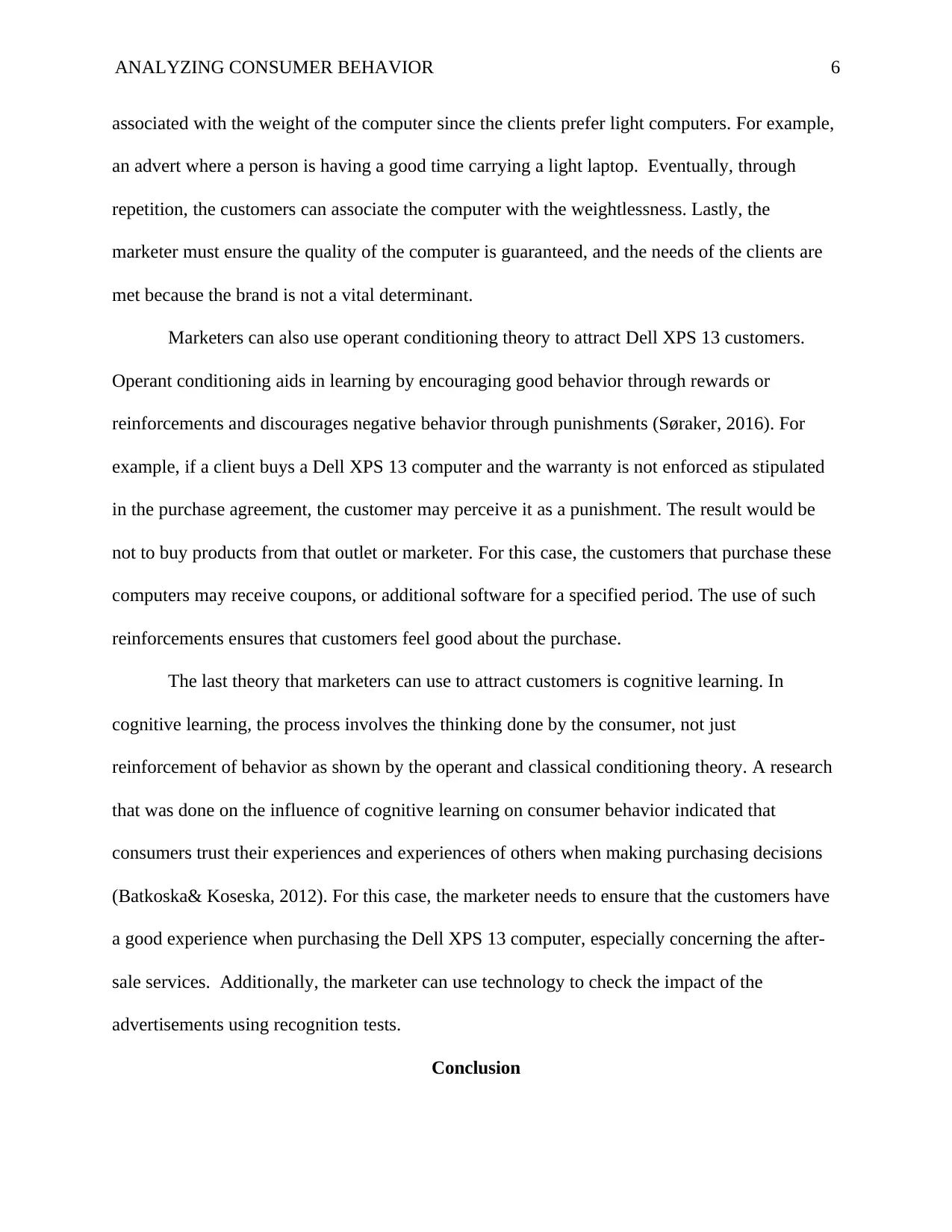
ANALYZING CONSUMER BEHAVIOR 6
associated with the weight of the computer since the clients prefer light computers. For example,
an advert where a person is having a good time carrying a light laptop. Eventually, through
repetition, the customers can associate the computer with the weightlessness. Lastly, the
marketer must ensure the quality of the computer is guaranteed, and the needs of the clients are
met because the brand is not a vital determinant.
Marketers can also use operant conditioning theory to attract Dell XPS 13 customers.
Operant conditioning aids in learning by encouraging good behavior through rewards or
reinforcements and discourages negative behavior through punishments (Søraker, 2016). For
example, if a client buys a Dell XPS 13 computer and the warranty is not enforced as stipulated
in the purchase agreement, the customer may perceive it as a punishment. The result would be
not to buy products from that outlet or marketer. For this case, the customers that purchase these
computers may receive coupons, or additional software for a specified period. The use of such
reinforcements ensures that customers feel good about the purchase.
The last theory that marketers can use to attract customers is cognitive learning. In
cognitive learning, the process involves the thinking done by the consumer, not just
reinforcement of behavior as shown by the operant and classical conditioning theory. A research
that was done on the influence of cognitive learning on consumer behavior indicated that
consumers trust their experiences and experiences of others when making purchasing decisions
(Batkoska& Koseska, 2012). For this case, the marketer needs to ensure that the customers have
a good experience when purchasing the Dell XPS 13 computer, especially concerning the after-
sale services. Additionally, the marketer can use technology to check the impact of the
advertisements using recognition tests.
Conclusion
associated with the weight of the computer since the clients prefer light computers. For example,
an advert where a person is having a good time carrying a light laptop. Eventually, through
repetition, the customers can associate the computer with the weightlessness. Lastly, the
marketer must ensure the quality of the computer is guaranteed, and the needs of the clients are
met because the brand is not a vital determinant.
Marketers can also use operant conditioning theory to attract Dell XPS 13 customers.
Operant conditioning aids in learning by encouraging good behavior through rewards or
reinforcements and discourages negative behavior through punishments (Søraker, 2016). For
example, if a client buys a Dell XPS 13 computer and the warranty is not enforced as stipulated
in the purchase agreement, the customer may perceive it as a punishment. The result would be
not to buy products from that outlet or marketer. For this case, the customers that purchase these
computers may receive coupons, or additional software for a specified period. The use of such
reinforcements ensures that customers feel good about the purchase.
The last theory that marketers can use to attract customers is cognitive learning. In
cognitive learning, the process involves the thinking done by the consumer, not just
reinforcement of behavior as shown by the operant and classical conditioning theory. A research
that was done on the influence of cognitive learning on consumer behavior indicated that
consumers trust their experiences and experiences of others when making purchasing decisions
(Batkoska& Koseska, 2012). For this case, the marketer needs to ensure that the customers have
a good experience when purchasing the Dell XPS 13 computer, especially concerning the after-
sale services. Additionally, the marketer can use technology to check the impact of the
advertisements using recognition tests.
Conclusion

ANALYZING CONSUMER BEHAVIOR 7
Personality and demographic theories can be used to explain consumer behavior. For
example, it can be seen that those who purchase Dell XPS 13 use the ego structure to decide
while those that purchase Dell Inspiron 17 5000 use id structure. In addition, the classical,
operant and cognitive learning theories can assist marketers in developing marketing strategies
that guarantee the purchase of products and brand loyalty. Therefore, it is crucial for
organizations to understand consumer characteristics and behavior.
Personality and demographic theories can be used to explain consumer behavior. For
example, it can be seen that those who purchase Dell XPS 13 use the ego structure to decide
while those that purchase Dell Inspiron 17 5000 use id structure. In addition, the classical,
operant and cognitive learning theories can assist marketers in developing marketing strategies
that guarantee the purchase of products and brand loyalty. Therefore, it is crucial for
organizations to understand consumer characteristics and behavior.
Paraphrase This Document
Need a fresh take? Get an instant paraphrase of this document with our AI Paraphraser
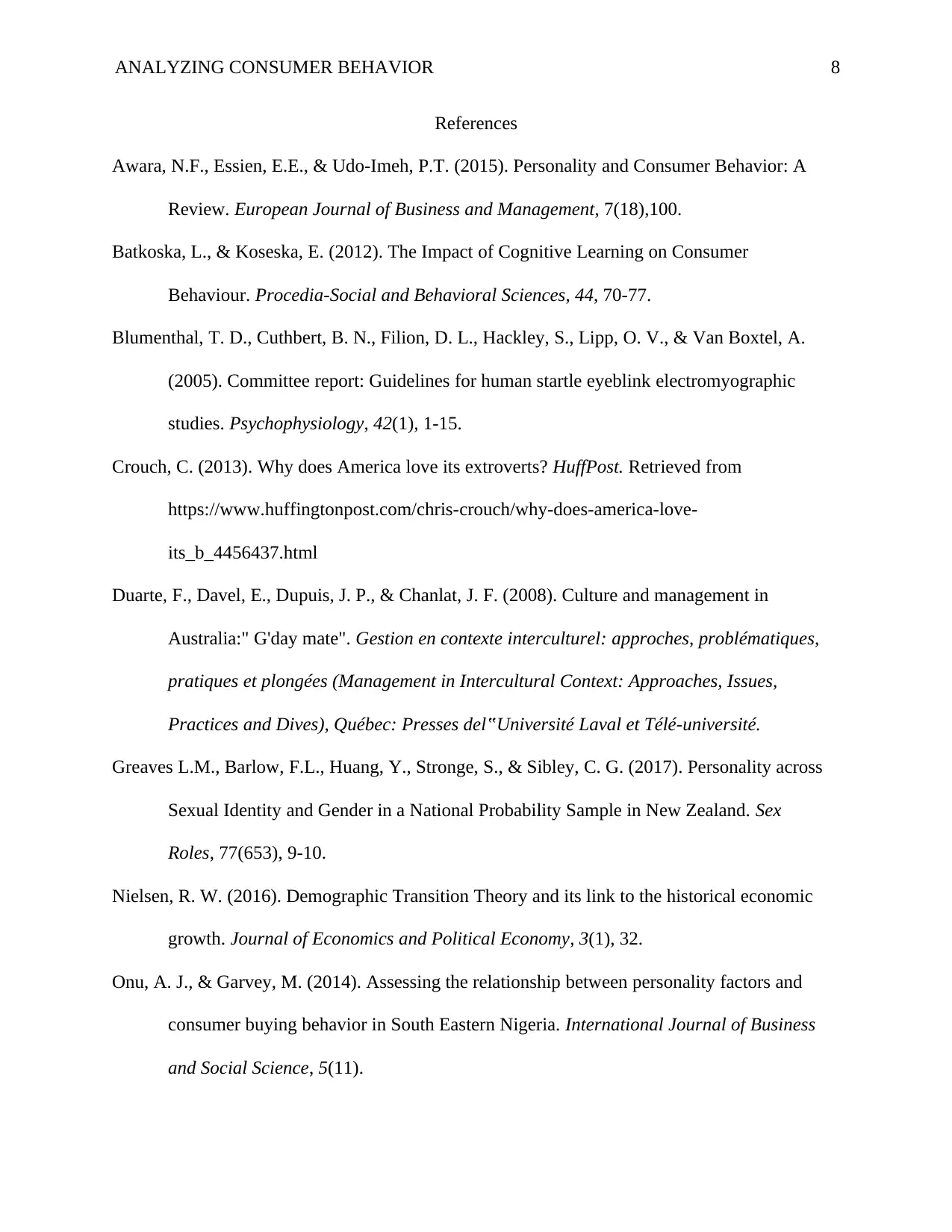
ANALYZING CONSUMER BEHAVIOR 8
References
Awara, N.F., Essien, E.E., & Udo-Imeh, P.T. (2015). Personality and Consumer Behavior: A
Review. European Journal of Business and Management, 7(18),100.
Batkoska, L., & Koseska, E. (2012). The Impact of Cognitive Learning on Consumer
Behaviour. Procedia-Social and Behavioral Sciences, 44, 70-77.
Blumenthal, T. D., Cuthbert, B. N., Filion, D. L., Hackley, S., Lipp, O. V., & Van Boxtel, A.
(2005). Committee report: Guidelines for human startle eyeblink electromyographic
studies. Psychophysiology, 42(1), 1-15.
Crouch, C. (2013). Why does America love its extroverts? HuffPost. Retrieved from
https://www.huffingtonpost.com/chris-crouch/why-does-america-love-
its_b_4456437.html
Duarte, F., Davel, E., Dupuis, J. P., & Chanlat, J. F. (2008). Culture and management in
Australia:" G'day mate". Gestion en contexte interculturel: approches, problématiques,
pratiques et plongées (Management in Intercultural Context: Approaches, Issues,
Practices and Dives), Québec: Presses del‟Université Laval et Télé-université.
Greaves L.M., Barlow, F.L., Huang, Y., Stronge, S., & Sibley, C. G. (2017). Personality across
Sexual Identity and Gender in a National Probability Sample in New Zealand. Sex
Roles, 77(653), 9-10.
Nielsen, R. W. (2016). Demographic Transition Theory and its link to the historical economic
growth. Journal of Economics and Political Economy, 3(1), 32.
Onu, A. J., & Garvey, M. (2014). Assessing the relationship between personality factors and
consumer buying behavior in South Eastern Nigeria. International Journal of Business
and Social Science, 5(11).
References
Awara, N.F., Essien, E.E., & Udo-Imeh, P.T. (2015). Personality and Consumer Behavior: A
Review. European Journal of Business and Management, 7(18),100.
Batkoska, L., & Koseska, E. (2012). The Impact of Cognitive Learning on Consumer
Behaviour. Procedia-Social and Behavioral Sciences, 44, 70-77.
Blumenthal, T. D., Cuthbert, B. N., Filion, D. L., Hackley, S., Lipp, O. V., & Van Boxtel, A.
(2005). Committee report: Guidelines for human startle eyeblink electromyographic
studies. Psychophysiology, 42(1), 1-15.
Crouch, C. (2013). Why does America love its extroverts? HuffPost. Retrieved from
https://www.huffingtonpost.com/chris-crouch/why-does-america-love-
its_b_4456437.html
Duarte, F., Davel, E., Dupuis, J. P., & Chanlat, J. F. (2008). Culture and management in
Australia:" G'day mate". Gestion en contexte interculturel: approches, problématiques,
pratiques et plongées (Management in Intercultural Context: Approaches, Issues,
Practices and Dives), Québec: Presses del‟Université Laval et Télé-université.
Greaves L.M., Barlow, F.L., Huang, Y., Stronge, S., & Sibley, C. G. (2017). Personality across
Sexual Identity and Gender in a National Probability Sample in New Zealand. Sex
Roles, 77(653), 9-10.
Nielsen, R. W. (2016). Demographic Transition Theory and its link to the historical economic
growth. Journal of Economics and Political Economy, 3(1), 32.
Onu, A. J., & Garvey, M. (2014). Assessing the relationship between personality factors and
consumer buying behavior in South Eastern Nigeria. International Journal of Business
and Social Science, 5(11).
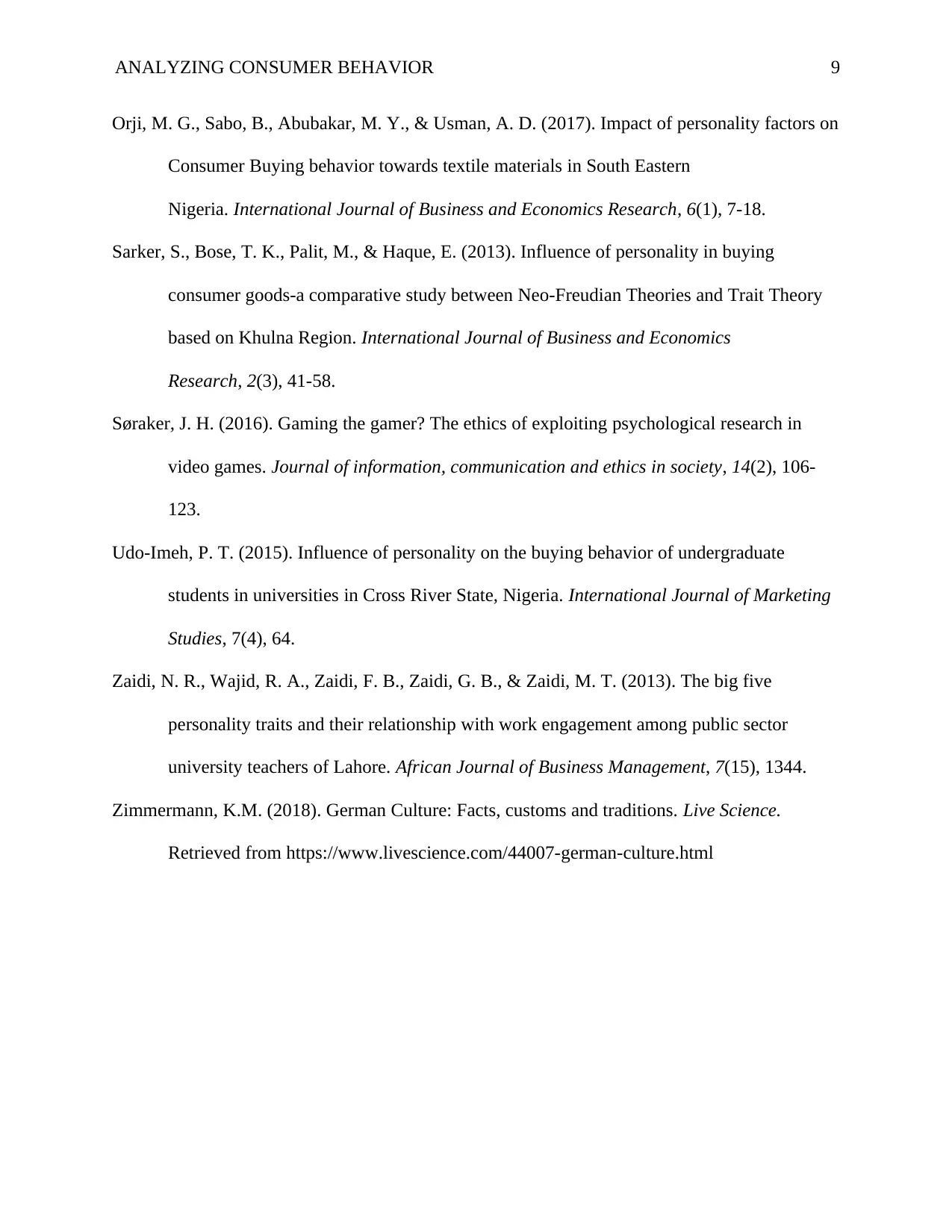
ANALYZING CONSUMER BEHAVIOR 9
Orji, M. G., Sabo, B., Abubakar, M. Y., & Usman, A. D. (2017). Impact of personality factors on
Consumer Buying behavior towards textile materials in South Eastern
Nigeria. International Journal of Business and Economics Research, 6(1), 7-18.
Sarker, S., Bose, T. K., Palit, M., & Haque, E. (2013). Influence of personality in buying
consumer goods-a comparative study between Neo-Freudian Theories and Trait Theory
based on Khulna Region. International Journal of Business and Economics
Research, 2(3), 41-58.
Søraker, J. H. (2016). Gaming the gamer? The ethics of exploiting psychological research in
video games. Journal of information, communication and ethics in society, 14(2), 106-
123.
Udo-Imeh, P. T. (2015). Influence of personality on the buying behavior of undergraduate
students in universities in Cross River State, Nigeria. International Journal of Marketing
Studies, 7(4), 64.
Zaidi, N. R., Wajid, R. A., Zaidi, F. B., Zaidi, G. B., & Zaidi, M. T. (2013). The big five
personality traits and their relationship with work engagement among public sector
university teachers of Lahore. African Journal of Business Management, 7(15), 1344.
Zimmermann, K.M. (2018). German Culture: Facts, customs and traditions. Live Science.
Retrieved from https://www.livescience.com/44007-german-culture.html
Orji, M. G., Sabo, B., Abubakar, M. Y., & Usman, A. D. (2017). Impact of personality factors on
Consumer Buying behavior towards textile materials in South Eastern
Nigeria. International Journal of Business and Economics Research, 6(1), 7-18.
Sarker, S., Bose, T. K., Palit, M., & Haque, E. (2013). Influence of personality in buying
consumer goods-a comparative study between Neo-Freudian Theories and Trait Theory
based on Khulna Region. International Journal of Business and Economics
Research, 2(3), 41-58.
Søraker, J. H. (2016). Gaming the gamer? The ethics of exploiting psychological research in
video games. Journal of information, communication and ethics in society, 14(2), 106-
123.
Udo-Imeh, P. T. (2015). Influence of personality on the buying behavior of undergraduate
students in universities in Cross River State, Nigeria. International Journal of Marketing
Studies, 7(4), 64.
Zaidi, N. R., Wajid, R. A., Zaidi, F. B., Zaidi, G. B., & Zaidi, M. T. (2013). The big five
personality traits and their relationship with work engagement among public sector
university teachers of Lahore. African Journal of Business Management, 7(15), 1344.
Zimmermann, K.M. (2018). German Culture: Facts, customs and traditions. Live Science.
Retrieved from https://www.livescience.com/44007-german-culture.html
1 out of 9
Related Documents
Your All-in-One AI-Powered Toolkit for Academic Success.
+13062052269
info@desklib.com
Available 24*7 on WhatsApp / Email
![[object Object]](/_next/static/media/star-bottom.7253800d.svg)
Unlock your academic potential
© 2024 | Zucol Services PVT LTD | All rights reserved.





